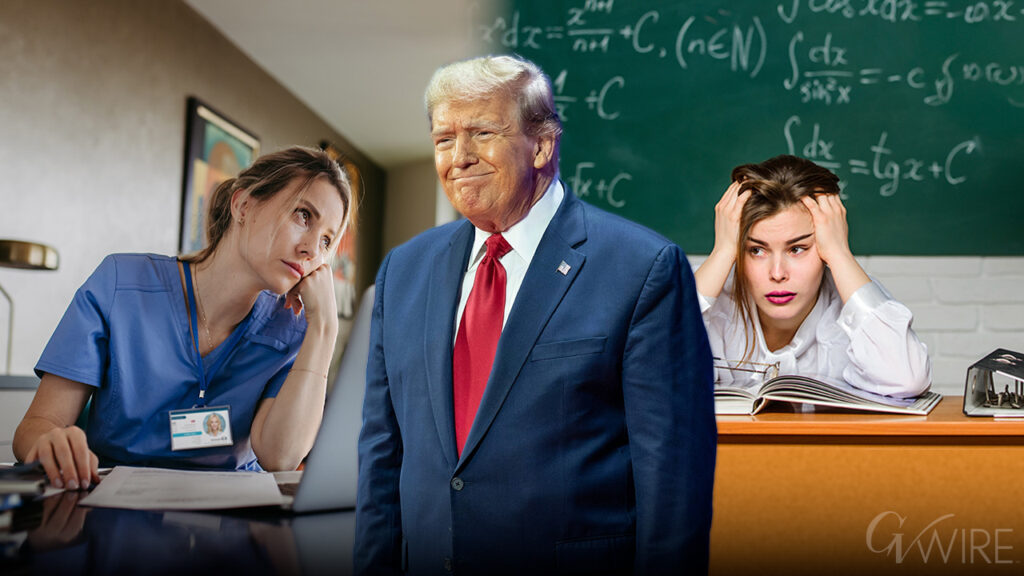President-Elect Donald Trump speaks to members of the press after paying his respects to former president Jimmy Carter and meeting with Senate GOP leadership iat the U.S. Capitol in Washington, Jan. 8, 2025. Trump’s advisers have spent months trying to find the right disease to build their case for closing the border. (Eric Lee/The New York Times)

- Trump's team eyes Title 42 despite lacking a public health crisis, targeting diseases to justify strict border policies.
- Advisers propose emergency declarations, stricter enforcement, and asylum restrictions in Trump’s immigration crackdown plans.
- Border calm contrasts with past surges, as Title 42’s effectiveness in reducing crossings remains under scrutiny.
Share
|
Getting your Trinity Audio player ready...
|
WASHINGTON — President-elect Donald Trump is likely to justify his plans to seal off the border with Mexico by citing a public health emergency from immigrants bringing disease into the United States.
Now he just has to find one.
Trump last invoked public health restrictions, known as Title 42, in the early days of the pandemic in 2020, when the coronavirus was tearing across the globe. As he prepares to enter office again, Trump has no such public health disaster to point to.
Still, his advisers have spent recent months trying to find the right disease to build their case, according to four people familiar with the discussions. They have looked at tuberculosis and other respiratory diseases as options and have asked allies inside the Border Patrol for examples of illnesses that are being detected among migrants.
Trying to Rationalize Title 42
They also have considered trying to rationalize Title 42 by arguing broadly that migrants at the border come from various countries and may carry unfamiliar disease — an assertion that echoes a racist notion with a long history in the United States that minorities transmit infections. Trump’s team did not respond to a request for comment.
The plan to invoke the border restrictions based on sporadic cases of illness or even a vague fear of illness — rather than a major disease outbreak or pandemic — would amount to a radical use of the public health measure in pursuit of an immigration crackdown. Even when the coronavirus was spreading, the use of the health authority to turn away migrants prompted scrutiny from the courts and public health officials.
Related Story: New Book Alleges Fox News Leaked Town Hall Questions to Trump Campaign
But Trump’s immigration advisers, led by Stephen Miller, his pick to be deputy chief of staff, believe they are entering a political environment that will welcome more aggressive border enforcement, particularly after some Democrats embraced using restrictions like Title 42, according to people familiar with the planning. President Joe Biden used it to turn away thousands of migrants before eventually deciding to lift it, well after his public health advisers said the restrictions were no longer useful for the purpose of stopping the spread of disease.
Title 42, which is part of the Public Service Act of 1944, grants power to health authorities to block people from entering the United States when it is necessary to avert a “serious danger” posed by the presence of a communicable disease in foreign countries.
Miller has long considered Title 42 a key tool for his goal of shuttering the border to migration. He has essentially been on a yearslong quest to find enough examples of diseases among migrants to justify the use of the law.
Miller Asked Aides to Monitor COVID Spread
Even before the spread of the coronavirus, Miller asked aides to keep tabs on American communities that welcomed migrants to see if diseases broke out there. He seized on an outbreak of mumps in immigration detention facilities in 2019 to push for using the public health law to seal the border. He was talked down in most of the cases by Cabinet secretaries and lawyers — until the advent of the coronavirus.
The Centers for Disease Control and Prevention, not the White House, is responsible for assessing whether the public health rule is necessary at the border. And even when the pandemic spread throughout the United States, CDC officials pushed back on the Trump White House’s position that turning away migrants was an effective way to prevent the spread of diseases.
Martin Cetron, director of the agency’s Division of Global Migration and Quarantine, told a House committee that the implementation of the border restrictions “came from outside the CDC subject matter experts” and was “handed to us” by the White House.
Related Story: New York’s Highest Appeals Court Declines to Block Trump’s ...
When Biden came into office, he initially kept the public health rule in place at the border, even when CDC officials told his top aides there was no clear public health rationale for keeping the border shut to asylum-seekers. Both the Biden and Trump administrations argued the rule was needed to prevent the spread of diseases in detention facilities at the border. But Biden’s top White House aides were privately concerned that lifting the rule would lead to a surge in migration.
Trump’s attempt to deter migration based on public health, even without a clear disease to justify its use, is just one expected piece of a flurry of Day 1 executive actions that his team is developing to crack down on immigration.
Trump’s Advisers Discussed Declaring National Emergency
Trump’s advisers have also discussed declaring a national emergency to free up Department of Defense funds and move military personnel, aircraft and other resources to the border. They also want to revive a policy that forced migrants to wait in Mexico, rather than the United States, until their immigration court date — although they would need Mexico to agree to such a deal.
Trump’s immigration advisers received a briefing on such border restrictions — as well as the use of the public health emergency restrictions — during a recent meeting with homeland security officials as a part of the transition between administrations, according to a person familiar with the matter. After exiting a meeting with Senate Republicans on Wednesday evening, Trump said he would close the border on his first day in office.
Some immigration experts have questioned how effective the public health rule was in driving down border crossings.
Related Story: Supreme Court Justice Samuel Alito Says He Spoke With Trump on Tuesday
From the time Title 42 was enacted in 2020 until it was lifted in 2023, border officials expelled people more than 2.5 million times. Biden administration officials have publicly argued that the use of Title 42 at the southern border drove an increase in migrants attempting to cross the border multiple times, a practice known as recidivism.
Blas Nuñez-Neto, a White House official, said that in that way, Title 42 “may have” actually led to an increase in border crossings that the administration struggled to handle.
The current state at the border has been particularly calm, especially when compared with the numbers seen a year ago. Border agents made more than 47,000 arrests in December, according to a senior U.S. Customs and Border Protection official, a major drop from the previous year when nearly 250,000 such arrests were made.
Biden officials put into a place a measure banning asylum for those who crossed the southern border starting this summer. It can only be lifted if crossing numbers drop to a certain threshold for several weeks, something that still has yet to happen.
—
This article originally appeared in The New York Times.
By Zolan Kanno-Youngs and Hamed Aleaziz/Eric Lee
c. 2025 The New York Times Company



















